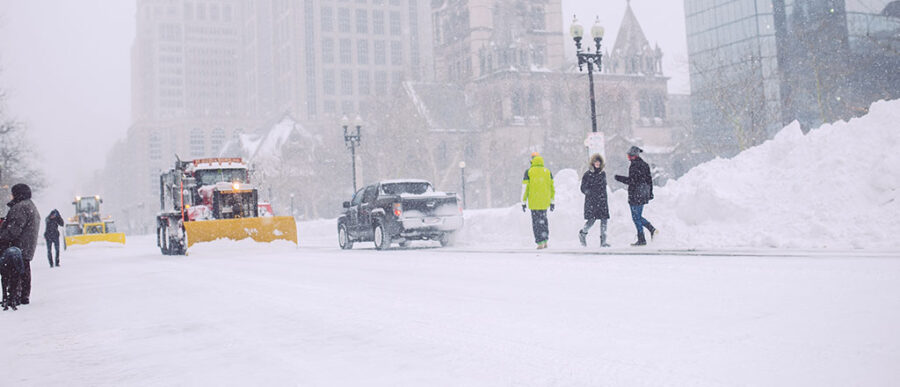This week’s storm that hit the U.S. Northeast was milder than predicted in many areas, and work disruptions were more because of preventive mass transit suspensions. Even so, bad weather conditions like rain and storms could actually lift productivity, according to Bradley Staats a visiting professor of operations and information management at Wharton.
Staats spoke of a “distraction effect,” where the lack of external distractions in bad weather conditions forces workers to focus more on the task at hand, resulting in better performance. “It’s innately human to see a distraction and want to go take part in it,” he said. “If we can find ways to limit that, then we can improve productivity.”
Those observations are the result of a paper Staats co-authored with Harvard University professors Jooa Julia Lee and Francesca Gino. The paper, titled “Rainmakers: Why Bad Weather Means Good Productivity,” was published last year in the Journal of Applied Psychology. Staats discussed the research behind the paper and the takeaways for companies on the Knowledge at Wharton show on Wharton Business Radio on SiriusXM channel 111. (Listen to the podcast at the top of this page.)
Staats noted that typically, people associate bad weather with low productivity. He and his co-authors decided to challenge that hypothesis, and wondered if bad weather would actually increase productivity. That led them to look at whether there might be a lack of distractions when the weather was bad.
“When you are sitting in your office and staring out at an 80-degree day, [you might think,] ‘I’d really like to be out in that,'” said Staats. However, “when it’s dumping rain or [you’re] in a blizzard, you might say, ‘What the heck? Why not focus on the work that is here in front of me?'”
“It’s innately human to see a distraction and want to go take part in it. If we can find ways to limit that, then we can improve productivity.”
That hypothesis proved right in three studies the paper’s authors conducted. In one, they looked at productivity data of a Japanese bank over several years. Here, they found evidence that bad weather (rain, in this case) meant better productivity. For their second study, they formed two groups of Harvard students exposed to sunny days and rainy days, respectively, and studied their productivity.
“We wanted to isolate this distraction effect,” said Staats. “One way to test that is to take a bad-weather day and provide some distractions. You may not be naturally thinking of gorgeous, sunny beaches, but if we put them in front of you on a bad-weather day, do we lose all of those intended benefits?” The third study was an online survey of people across the U.S.
Staats felt the research study he co-authored could offer useful management tools for organizations. “Task allocation is a challenge for most of us,” he said. “We’ve got to decide what do we do [and] when to do it.” For example, managers could decide on a bad-weather day that it might be the right time “to take on some of those boring tasks,” he added. Here, he noted that airplanes are good places to get things done. “If I limit what I bring on the airplane, then I have no choice but to do the work that’s in front of me. It’s like you are creating constraints on yourself.”
According to Staats, many organizations are paying attention to weather in site selection. He acknowledged that weather is not the sole decision-making factor as organizations decide on their locations. However, he said firms would do well to consider the “distraction argument” as it relates to bad weather. Organizations would benefit by “appreciating that there may be times when Seattle is good, with sunny days, but also that wherever we happen to be, we manage within the constraints.”
“When it’s dumping rain or [you’re] in a blizzard, you might say, ‘Why not focus on the work that is here in front of me?'”
Distraction vs. Disruption
Workers could use the distraction effect in other ways as they prioritize their tasks, according to Staats. For example, on bad-weather days, they might remind themselves that things will get better and decide to “take a little bit of that slog today and get it out of the way — and fight that desire to procrastinate.” Alternatively, they might decide to work hard for a few hours and earn themselves some time off “to play in the snow with the kids,” he said. “That also matches well with the rhythm of the work day — we need some breaks.”
Bad weather, of course, is not a blessing in all situations, Staats pointed out, noting that companies must look at the aspect of “distraction versus disruption.” Companies that rely on supply chains would find bad weather disruptive and see their productivity falling — unlike, say, at a law firm or an accounting firm with local clientele, he noted. In the case of the Japanese bank that the paper’s authors studied, they found that every extra inch of rain was related to several percentage points of higher productivity. “[However,] if you are trying to work outside and you have blizzard conditions, the result would be different,” he said.
Here, Staats referred to the research done on work disruption by Gérard Cachon, Wharton professor of operations and information management, and his colleagues. That research looked at automotive production, which has “more interaction with the elements” — such as in activities like shipping and receiving, and trucks bringing in inventory. They found that large-scale weather disruptions cause a 5%-10% hit on productivity with absent workers or undelivered equipment, Staats noted. Similarly, people in trade jobs — like plumbers — have less control over their work in bad weather conditions than assembly-line workers, he added.



